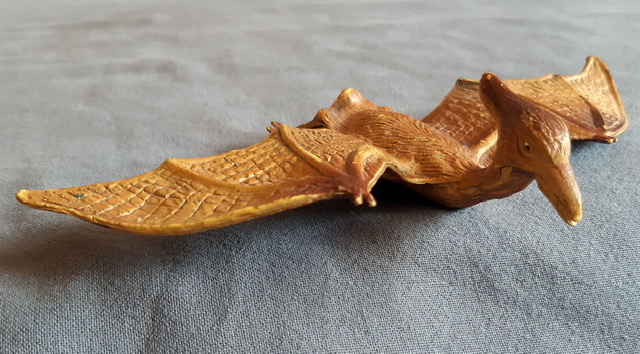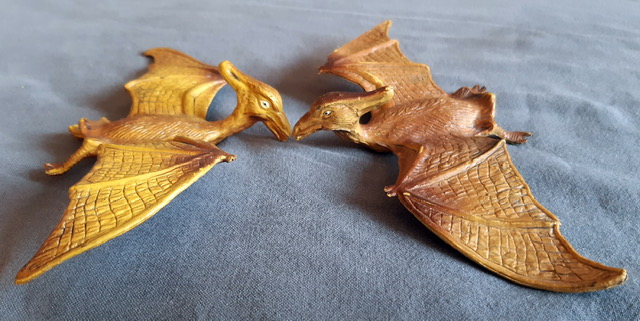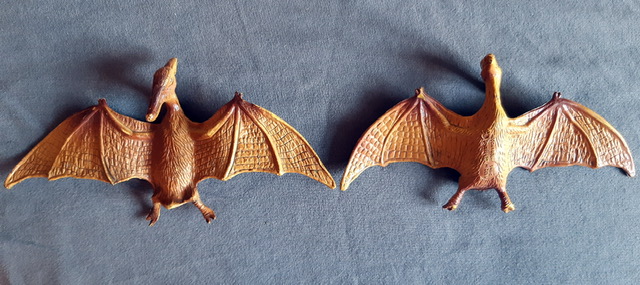Review and photographs by Funk, edited by Suspsy
It probably wouldn’t be an exaggeration to say that Pteranodon is the most popular of all pterosaurs, and probably the one with most toys to its name. To this day, it remains one of the most recognisable pterosaurs, if not prehistoric animals in general, no doubt due to its very distinct head crest. Here I’ll review UKRD’s 1992 attempt at the genus, which is in many ways quite baffling in the way they chose to depict it.

Pteranodon has at times been depicted in some seemingly intentionally inaccurate ways, with the three main ones being: 1. With teeth, even though the very name Pteranodon means “toothless wing”; 2. With a Rhamphorchynchus-like tail, presumably because its body was not interesting enough (too generically pterosaurian), whereas this chimaera is sort of the ultimate pop cultural “pterodactyl”; 3. With bat wings where the patagium (the wing membrane) is distended between several fingers, whereas it was distended by a single finger in pterosaurs. Add to that any combination of the three, which I’m sure must have been depicted out there somewhere.
This toy is a case of Type 3: bat-like wings, but in a pretty unique way. While bats distend their patagia with four fingers, leaving the thumb free, and pterosaurs distended theirs with one finger, leaving three fingers free, this toy seems to be the exact middle ground, with three fingers distending the patagium, and two fingers free. This is extremely odd, and I don’t think I’ve seen that elsewhere. Add to that, there are only two toes on each foot, when there should have been five (and the legs are very short). Such “artistic licence” is otherwise uncommon in the UKRD line, as while most of their figures were outdated by the time they came out, many of them were at least imitations of John Sibbick’s artwork for the 1985 Illustrated Encyclopaedia of Dinosaurs, and therefore not pure fantasy.

The figure also adds another inaccuracy, which is otherwise rare in Pteranodon toys: an extremely short beak. In fact, looking at the head overall, it looks more like a bird than a pterosaur, and while the crest is also unusually short, we do know now that female and juvenile Pteranodon would have had much shorter crests than mature males (the shape here doesn’t match the fossils, nonetheless). The short beak is just unforgivable, though, as the beak alone would have been about twice the length of the body, and that was known at the time.
In contrast to these odd inaccuracies, the toy actually has nicely sculpted hair-like pycnofibres all over its body, so the design is overall an odd mix of pure fantasy, inaccuracy, and pretty modern interpretations. I can’t help but imagine that if they had followed Sibbick’s artwork for the 1991 Illustrated Encyclopaedia of Pterosaurs like they did with the dinosaurs, it could have been a very accurate toy for its time, since the pterosaurs depicted for that book were much more modern-looking than his earlier dinosaurs (seemingly based on some of writer Peter Wellnhofer’s own drawings for the book). The wing membranes have cross-hatched striations, which seems like it is supposed to look like the similar wrinkles on bat wings, but the resulting patterns of squares is probably unfitting for pterosaurs.

Moving on to the colouration, it hits another old “meme,” the orange Pteranodon. I am not sure how or when this began, but back in the day, there seemed to have been a consensus that Pteranodon in particular, as well as many other pterosaurs, were uniformly orange. So deeply ingrained is this idea that when I see non-orange depictions of Pteranodon, it is almost hard to recognise them as that genus. This toy is no exception; it is made of orange plastic, with some orange-brown paint wash to fill up the various cracks. It is darkest around the crest and hands for some reason. The only different colour is white for the eyes, with black dots for the pupils.
Since the UKRD toys were cheap and mass-produced, they were pretty easy to get, and I therefore ended up with more than one of some figures, which is the case with the Pteranodon. This makes it possible to find differences in how copies of the same toy were manufactured, and here, it is especially noticeable in the colouration, with one toy being browner overall, and the other more orangey. The former also has neater-looking eyes, with the white of the sclera following the contours defined by the sculpture, but the eyes of the other toy just seem to have been splashed on, bleeding outside the borders of the sculpted eyes, which always looks pretty annoying.

Looking at the plastic itself, it is interesting to see that the browner figure seems to be much “firmer,” with a small gap between the upper and lower jaws at the front, and space between the toes. The more orange figure instead has a kind of “membrane” between the toes, and the gap between the jaws is filled, making the beak look much more massive and more curved. I assume the casting process of the plastic just leaves a lot of room for inconsistency, especially when it comes to cheaper productions
That was an awful lot about a cheap, mass-produced toy from the 90s. It is a very inaccurate toy, but I can’t help but feel frustration over it being a missed opportunity, since the other toys in the line weren’t as bad, and since it has pycnofibres after all, which did hint at some attention to scientific accuracy. It was pretty fun to play with as a child (the bendable wings allowed for nice flapping action), though, and that was the purpose of it, not to be a display piece.

Support the Dinosaur Toy Blog by making dino-purchases through these links to Ebay and Amazon. Disclaimer: links to Ebay.com and Amazon.com on the The Dinosaur Toy Blog are often affiliate links, when you make purchases through these links we may make a commission

I do own one of this models! This was the only dinosaur figure my parents ever bought me. The others were gifts of some food articles, it was the Jurassic Park boom, all wanted to give dinosaur figures.
But this pteranodon was a Christmas present along with David Norman’s Encyclopaedia of Dinosaurs. I was over the moon!
Mine is more like the second in the right.
Sweet!
Well, on a positive note it has at least only five fingers on each hand unlike Harryhausen’s six-fingered version. That doesn’t make it any more accurate but at least more plausible as a hypothetical flying amniote. Cryptid diorama, anyone?
Maybe it could be passed off as a Kongamato?
Texas pterodactyl would also be excellent, just needs an appropriately dressed human figure to hold the creature up and you got an instant diorama, looking like those old hoax photographs.
In all fairness the quality of the UKRD pteranodon is vastly inferior to its dinosaur counterparts. Nice, explanatory article on topical paleointerpretations of pteranodon by some toy dinosaur companies.